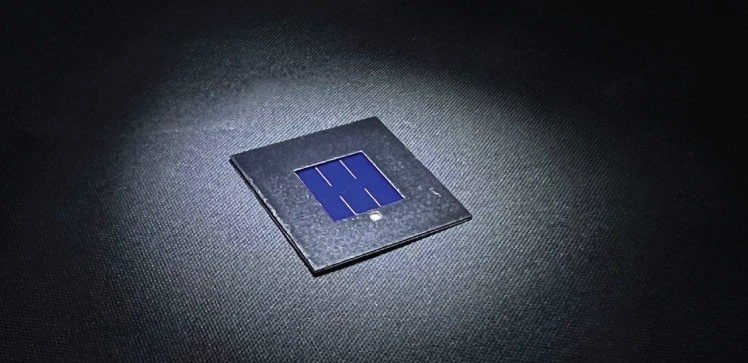Researchers from KAUST discovered that adding a metal fluoride layer to multilayered perovskite-silicon tandem solar cells can stop charge recombination and improve performance.
 Considerable performance gains in perovskite–silicon tandem solar cells (such as that pictured above) can be achieved by adding a magnesium fluoride interlayer. Image Credit: Erkan Aydin, KAUST
Considerable performance gains in perovskite–silicon tandem solar cells (such as that pictured above) can be achieved by adding a magnesium fluoride interlayer. Image Credit: Erkan Aydin, KAUST
Tandem solar cells, which combine silicon-based and perovskite subcells in one device, are projected to gather and convert sunlight into power more effectively and more affordably than their single-junction silicon analogs.
The pairs of electrons and positively charged holes that are produced when sunlight strikes the perovskite subcell, however, tend to combine again at the interface between the perovskite and the electron-transport layer.
Additionally, a mismatch in energy levels at this contact prevents the separation of electrons within the cell. These issues together reduce the tandem cells’ open-circuit voltage or maximum operating voltage, which restricts device performance.
By adding a layer of lithium fluoride between the perovskite and the electron-transport layer, which typically contains the electron-acceptor fullerene (C60), these performance concerns can be partially resolved. However, the devices become unstable because lithium salts easily liquify and disperse through surfaces.
None of the devices have passed the standard test protocols of the International Electrotechnical Commission, prompting us to create an alternative.
Jiang Liu, Study Lead Author and Postdoctoral Researcher, King Abdullah University of Science and Technology
Other metal fluorides, such as magnesium fluoride, have been extensively researched by Liu, Stefaan De Wolf, and others for use as interlayer materials at the perovskite/C60 interface of tandem cells.
Prior to adding C60 and the top contact components, the researchers thermally evaporated the metal fluorides on the perovskite layer to create an ultrathin, homogeneous film with regulated thickness. In accordance with the criteria of the inverted p-i-n solar cell, the interlayers are also very stable and transparent.
While displacing C60 from the perovskite surface, the magnesium fluoride interlayer efficiently boosted electron extraction from the perovskite active layer. This decreased interface charge recombination and improved charge transport within the subcell.
The resultant tandem solar cell has one of the greatest efficiencies for perovskite-silicon tandem cells, according to Liu, with a verified stable power conversion efficiency of 29.3% and a 50-millivolt improvement in open-current voltage.
Liu added, “Considering that the best efficiency is 26.7% for mainstream crystalline silicon-based single-junction cells, this innovative technology could bring considerable performance gains without adding to the cost of fabrication.”
The team is developing scalable techniques to construct perovskite-silicon tandem cells with areas more than 200 cm2 at an industrial scale to further investigate the practicality of this technology
Liu concluded, “We are also developing several strategies to obtain highly stable tandem devices that will pass the critical industrial stability protocols.”
Journal Reference:
Liu, J., et al. (2022) Efficient and stable perovskite-silicon tandem solar cells through contact displacement by MgFx. Science. doi:10.1126/science.abn8910.